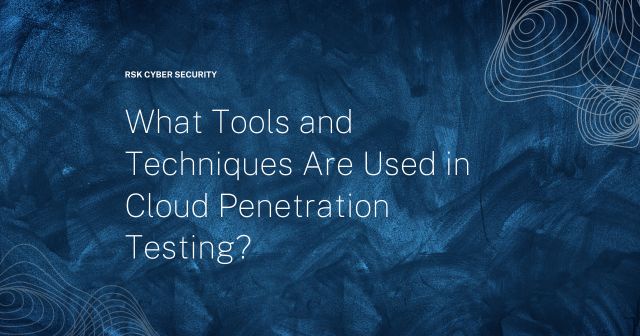Establishing a cloud-based business offers significant operational efficiency and cost-effectiveness advantages. While cloud providers adhere to security regulations and implement privacy policies, more than these measures are required. Therefore, in this discussion, we will explore the importance of cloud pen testing and the tools and techniques used.
Penetration testing cloud involves deliberately exploring and exploiting vulnerabilities identified through vulnerability scans. This practice enhances security awareness for cloud providers and customers, helping them understand potential damages from data breaches.
Why Does Cloud Pen Testing Play a Vital Role?
Cloud Penetration Testing ensures cloud systems and data security and resilience. It offers the following benefits:
- Identifying Vulnerabilities: By simulating real-world attacks, it reveals weaknesses in cloud infrastructure, configurations, and applications.
- Mitigating Risks: Proactive testing helps address vulnerabilities, reducing the risks of data breaches and unauthorized access.
- Compliance: Cloud Penetration Testing helps meet industry and regulatory requirements, demonstrating a commitment to data protection.
- Enhanced Security: Regular testing strengthens the security posture of cloud systems, staying ahead of emerging threats and implementing necessary controls.
- Customer Trust: By conducting Cloud Penetration Testing, organizations build customer trust by showcasing their dedication to secure cloud environments.
What are the Best Cloud Pen Testing Tools?
1. AWS Inspector
AWS offers a tool called AWS Inspector, which scans AWS instances to detect vulnerable operating systems and applications. It functions similarly to Nessus or Qualys but with the advantage of easy deployment for AWS clients. However, there are some differences in detection capacity, and AWS Inspector is not included in the Gartner magic quadrant.
Not all AWS users have access to this tool, and it cannot be deployed in a different local environment to scan AWS instances remotely. Due to these limitations, some may argue that it should not be considered a useful penetration testing tool.
2. Nmap
Nmap is a robust network mapping and scanning tool widely recognized among experienced penetration testers. It serves multiple purposes in cloud security assessments.
Penetration testers can employ Nmap to map the cloud network and gain insights into its architecture. During the scanning phase, Nmap can also identify open ports and potential vulnerabilities.
Nmap's vulnerability scanning system relies on community-developed NSE scripts designed explicitly for publicly disclosed vulnerabilities. These scripts enhance Nmap's capabilities to detect and assess vulnerabilities effectively.
3. Pacu
Pacu is a top-notch, freely available cloud pen testing tool that operates on an open-source framework hosted on GitHub. Its primary objective is to automate the identification of configuration vulnerabilities within an AWS network.
The tool facilitates efficient enumeration of the environment and enables penetration testers to extract user permissions for potential privilege escalation swiftly. With its modular architecture, the community can develop custom modules to execute various attacks on the AWS environment.
Pacu also offers features for creating backdoors to streamline access. It provides options like backdooring EC2 security groups or adding AWS API keys to user accounts. These functionalities enhance the tool's versatility in assessing and securing the cloud environment.
4. Cred Scanner
Cred Scanner is a straightforward Python script designed to scan for AWS credentials stored in files. While it lacks advanced features, its advantage lies in easy integration within CI/CD environments. Additionally, it can be seamlessly incorporated with Jenkins.
One of the significant risks large companies face is data breaches resulting from publicly exposed AWS keys. A prime example is the 2019 data breach suffered by Imperva, where customer data, including email addresses, hashed passwords, TLS, and API keys, were inadvertently exposed due to an exposed AWS key.
To mitigate such risks, it is crucial to utilize tools like Cred Scanner to ensure the absence of publicly accessible API keys.
5. CloudFront
Cloudfrunt is a valuable Python script specifically created to detect domain misconfigurations. It focuses on misconfigurations related to CloudFront, AWS's content distribution technology, allowing administrators to utilize their domain names to communicate with distributions. This specific domain name is referred to as the alternate domain name.
However, being aware of the risks associated with domain misconfigurations is crucial. An attacker could exploit this vulnerability by adding domain names one by one, creating an alternate domain name for their distribution using your subdomain. Subsequently, they could hijack the main domain, leading to unauthorized control over the domain and potentially malicious activities.
Bottom Line
Cloud pen testing is critical to ensuring the security and resilience of cloud-based systems. Various tools and techniques are utilized to effectively assess and fortify cloud environments. These tools enable penetration testers to identify vulnerabilities, map networks, scan for misconfigurations, and detect exposed credentials. Additionally, employing techniques like vulnerability scanning, privilege escalation, and backdoor creation enhances the effectiveness of the penetration testing cloud.
Embracing the ever-evolving landscape of cloud security, cloud pen testing remains a vital component in safeguarding cloud infrastructure.


No comments yet